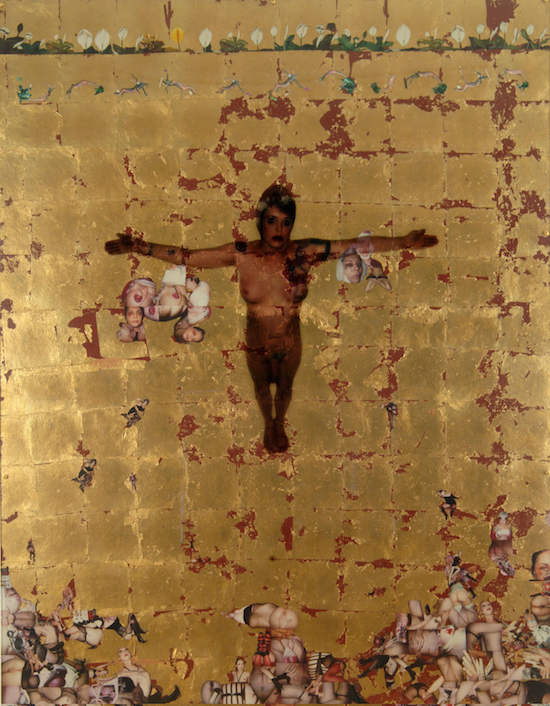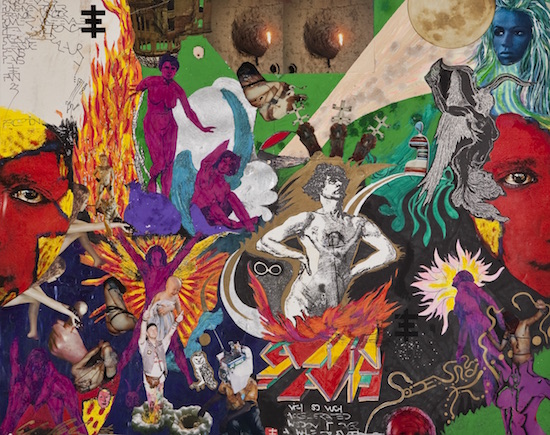It’s hard to decide where to begin looking at, much less deciphering Genesis Breyer P-Orridge. Over six decades, s/he has been many things. Much of P-Orridge’s efforts have been about challenging and subverting societal norms, through a sort of esoteric and contrarian carnival barker guise.
P-Orridge was a transgressive neo-dada art provocateur in the late ‘60s and early ‘70s, and “wrecker of civilization”. A pioneer of industrial music in the late ‘70s with Throbbing Gristle, and a psychedelics-dosing spiritual seeker during the punk and post-punk years. In the 80s, s/he transformed into a self-proclaimed godfather of acid house with Psychic TV, and the figurehead of Thee Temple ov Psychick Youth, a network of artists and magicians that morphed into something of a cult before P-Orridge’s departure. And then of course there is the Genesis who, with h/er partner Lady Jaye, began transforming h/er body through cut-up-esque body modification so that the two could become one pandrogynous being.
Many of these selves appear in P-Orridge’s new exhibition Try to Altar Everything, now on at The Rubin Museum of Art in New York City. As a centre for the art and culture of the Himalayas, India and neighbouring regions, the Rubin sounds like a rather strange bedfellow for a P-Orridge exhibition. But s/he spent years in the Kathmandu Valley of Nepal, where people often profess hybrid spiritual traditions (some simultaneously ascribe to Hinduism and Buddhism, for instance). P-Orridge and Lady Jaye identified with this fluidity as artists and persons, fusing this spiritual variety with William S. Burroughs and Brion Gysin’s cut-up technique for their mutual Pandrogeny project – an artistic and personal initiative that continues even after Lady Jaye’s death.
P-Orridge tells The Quietus that the exhibition had its origins in conversations with the Rubin curator Beth Citron. The two met through the gallerists at Invisible-Exports.
“Beth found out that we’d been traveling back and forth to Nepal for the last twenty years almost, and was interested by that, so we were invited to go give a guided talk,” P-Orridge says. “So we were a tour guide and picked out different items that triggered thoughts that we wanted to share – Kathmandu Valley, Tibetan art, and so on.”
“Then she invited us to give a talk on modern art and that sold out and was well-received, which is when she started thinking that there’s a connection between Breyer-P-Orridge and how they make things and where they’ve traveled and the works that are in this museum,” s/he adds. “Wouldn’t it be interesting to conceive of some kind of interface between what could be seen as contemporary shamanic work and ancient shamanic work? It was all Beth Citron’s fault.”
To reach Try to Altar Everything, you ascend The Rubin’s lift to the top floor. It’s an appropriate location given the exhibition’s focus on Eastern mythology, ritual and devotion. When the doors part, and you take first steps into the space, you are met by Thee Ghost, a work based upon P-Orridge’s ever-present Thee Psychick Cross. Only this particular manifestation glows in blue neon, and is suspended over a spiral staircase that descends toward The Rubin’s bottommost floors. P-Orridge seems to be immediately announcing your entry into a temple – h/er temple – of many selves, artistic and otherwise.
Just beyond the neon cross and spiral staircase stands the next installation, Gateway to Pandrodise: Walk Towards Thee Light (2010). These luminous life-size images present the artist over the tops of repurposed caskets. One features P-Orridge as h/er current self, the other finds Lady Jaye superimposed on Genesis as a symbol of their Pandrogeny. These doubles produce the modern equivalent of stained glass artworks in early Christian churches and monasteries – probably by design. And if anyone is thinking of P-Orridge as the short-haired frontman of Throbbing Gristle and Psychic TV, then they will also notice how these twin works shine a light on h/er metamorphosis.
After taking these in, the next work you see is a telephone installation that visitors can pick up to hear P-Orridge’s audio commentary for the exhibition. Along the back wall is Cruciform, in which P-Orridge evokes Salvador Dali’s depiction of Jesus Christ’s crucifixion in Christ of St. John the Cross. Like the religious art at the rear of a Christian church, this work is the altarpiece. The gold leaf that lies underneath P-Orridge’s body in crucifixion pose is meant as a nod to conventions in religious art. It’s also a rather sarcastic nod to Christianity, though P-Orridge insists that h/er devotional practice is “sincere and paramount”. The work’s top row features flora grown at P-Orridge’s home, while the bottom presents worms (a hermaphoditic species) that lived in h/er garden and “represent one ideal of Pandrogeny”.

Elsewhere, there is a great deal of blood. P-Orridge applies h/er blood to “hand-made Tibetan toilet paper” in Sacred Sc(roll). While getting blood drawn and injections at a Kathmandu hospital, s/he realised the blood resembled pictographs, so s/he turned the stained toilet paper into something that looks like the traditional good luck scroll paintings seen in Chinatown. It’s a bit of a conceptual stretch, but it’s still interesting seeing P-Orridge’s blood on toilet paper linking low culture (the bathroom, ketamine use) with high religious culture.
In Bloody Bunny, P-Orridge and Lady Jaye’s blood – gathered during ketamine injections – is rubbed on a wooden rabbit purchased in Mexico. The injections were experiments in psychically leaving the body behind. Like some of the other artworks that feature relics of Lady Jaye’s body (such as nail clippings and skin debris), her blonde ponytail is fixed to the wooden rabbit. Again, more ritual – this time inspired by African Voodoo traditions, where bodily elements represent spiritual power.
The symbolic meaning of some of the works would remain obscure or unknowable without P-Orridge’s description of the work, or some knowledge of h/er personal and artistic history. Then again, this seems to be h/er point: we imbue objects, whether artworks, personal effects or religious iconography, with meaning.
The Try to Altar Everything cabinet installation, where visitors are encouraged to make offerings that are “potent or interesting”, is the purest representation of this notion. P-Orridge’s stated goal is to show “that every person and thing can be made sacred, and h/er desire to alter every thing, including expectations of how people and objects should look and act”.
At first glance, this could seem like a pretentious attempt to conceptualise artwork. Tongue Kiss, in particular, would probably embody this viewer interpretation. Two wolf heads face each other in a rotating dance, their mouths outfitted with knives nearly touching. It’s interesting to look at, maybe even vaguely like standing before a cynical Damien Hirst piece (for some viewers), but it’s really a nod to P-Orridge’s “personal mythology” since founding Thee Temple ov Psychick Youth. The collective was occasionally called a “wolf pack” because of the metaphor’s ease, but they also helped fund the care of wolves at the London Zoo. And when the wolves died of natural causes, they were preserved through taxidermy.
While in the Kathmandu Valley last year with Citron, P-Orridge had Tibetan refugees make the little psychick crosses that visitors get in return for bringing something to place in the cabinet installation. Tibetan refugees also made the rug that appears in the show, which was meant as a sort of interpretation of P-Orridge and Lady Jaye as two halves of a deity equivalent to Shiva and Parvati, a male-female binary of creation and regeneration.
“It was important to us to make sure that the money went back to the people who we were also influenced by,” P-Orridge says. "We would have had it made in China, but that wouldn’t have had meaning – this way it had more meaning.”
“We’ve always felt that art is also functional,” s/he adds. “The art that interests us is the art that makes things happen. That’s why we got so interested in art that isn’t made for aesthetic judgments or because it looks nice in a penthouse. You make art to make something else happen… We are taking everything and making it sacred.”
So for P-Orridge, Try to Altar Everything is all about the devotion, the ritual and the meaning of things. And it’s your job as the viewer to see it. More than that, it’s your task to seek out your own meanings. Some works exceed others in their execution, but none are boring. Far from being conceptually alienating like a lot of modern art, P-Orridge’s modus operandi represents this very basic idea that is all too human. An idea that extends from objects to a person’s many-splendored selves.
Genesis P-Orridge: Try To Altar Everything is at the Rubin Museum until 1 August


